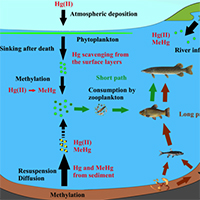Mercury methylation in oxic aquatic macro-environments: a review

Accepted: 27 February 2021
HTML: 106
All claims expressed in this article are solely those of the authors and do not necessarily represent those of their affiliated organizations, or those of the publisher, the editors and the reviewers. Any product that may be evaluated in this article or claim that may be made by its manufacturer is not guaranteed or endorsed by the publisher.
Authors
Mercury methylation in aquatic environments is a key process that incorporates this neurotoxin into the food chain and ultimately the human diet. Mercury methylation is considered to be essentially biotic and mainly driven by sulfate-reducing bacteria present in the bottom sediments in aquatic systems. However, in recent decades, many researchers have shown that this methylation also occurs in oxic layers in conjunction with a high content of particulate organic matter and localized depletion of dissolved oxygen. The goals of this review are to summarize our current understanding of Hg methylation in water columns of both marine and freshwater environments, as well as to highlight knowledge gaps and future research needs. Most of the literature showed that suspended particles (known as marine and lake snow) could be the microenvironment in which Hg methylation could occur across oxic water columns, because they have been recognized as a site of organic matter mineralization and as presenting oxygen gradients around and inside them. To date, the majority of these studies concern marine environments, highlighting the need for more studies in freshwater environments, particularly lacustrine systems. Investigating this new methylmercury production environment is essential for a better understanding of methylmercury incorporation into the trophic chain. In this review, we also propose a model which attempts to highlight the relative importance of a MeHg epilimnetic path over a MeHg benthic-hypolimnetic path, especially in deep lakes. We believe that this model could help to better focus future scientific efforts in limnic environments regarding the MeHg cycle.
Edited by
Diego Fontaneto, CNR-IRSA, Verbania, ItalyHow to Cite

This work is licensed under a Creative Commons Attribution-NonCommercial 4.0 International License.
Similar Articles
- José BARQUÍN, Russell G. DEATH, Downstream changes in spring-fed stream invertebrate communities: the effect of increased temperature range? , Journal of Limnology: Vol. 70 No. s1 (2011): Springs: neglected key habitats for biodiversity conservation
- Yosef Z. YACOBI, Ilia OSTROVSKY, Helen M. TALBOT, Occurrence of high concentrations of a unique degradation product of chlorophyll-a in particles residing below the thermocline throughout a period of oxygen depletion in Lake Kinneret , Journal of Limnology: Vol. 60 No. 2 (2001)
- Luca MISERERE, Franco MONTACCHINI, Giorgio BUFFA, Ecology of some mire and bog plant communities in the Western Italian Alps , Journal of Limnology: Vol. 62 No. 1 (2003)
- Zhuo Zhang, Changchun Huang, Fei Guo, Zhiyao Song, Di Hu, A new technology for suspended sediment simulation in Lake Taihu, China: Combination of hydrodynamic modeling and remote sensing , Journal of Limnology: Vol. 78 No. 1 (2019)
- Birna Vár Trygvadóttir, Reinhard Møbjerg Kristensen, A zoogeographic study of the limnoterrestrial tardigrade fauna on the Faroe islands , Journal of Limnology: Vol. 72 No. s1 (2013): 12th International Symposium on Tardigrada
- Svein Birger WÆRVÅGEN, Jens Petter NILSSEN, Life histories and seasonal dynamics of common boreal pelagic copepods (Crustacea, Copepoda) inhabiting an oligotrophic Fennoscandian lake , Journal of Limnology: Vol. 69 No. 2 (2010)
- Walter Ambrosetti, Luigi Barbanti, Angelo Rolla, THE CLIMATE OF LAGO MAGGIORE AREA DURING THE LAST FIFTY YEARS , Journal of Limnology: Vol. 65 No. s1 (2006): The Climate Of Lago Maggiore Area During The Last Fifty Years
- Cristiana CALLIERI, Roberto BERTONI, Gianluca CORNO, Dynamics of bacteria and mixotrophic flagellates in an Alpine lake in relation to Daphnia population development , Journal of Limnology: Vol. 61 No. 2 (2002)
- Anna Maria NOCENTINI, Angela BOGGERO, Giovanna DE MARGARITIS, Marcella GIANATTI, First phase of macroinvertebrate repopulation of Lake Orta (Buccione Basin) after liming , Journal of Limnology: Vol. 60 No. 1 (2001)
- Lluís CAMARERO, Marisol FELIP, Marc VENTURA, Frederic BARTUMEUS, Jordi CATALAN, The relative importance of the planktonic food web in the carbon cycle of an oligotrophic mountain lake in a poorly vegetated catchment (Redó, Pyrenees) , Journal of Limnology: Vol. 58 No. 2 (1999)
<< < 61 62 63 64 65 66 67 68 69 70 > >>
You may also start an advanced similarity search for this article.
-
Juanjo RodríguezFrontiers in Marine Science : 2023
-
Thibaut Cossart, Javier Garcia-Calleja, João P. Santos, Elaheh Lotfi Kalahroodi, Isabelle A. M. Worms, Zoyne Pedrero, David Amouroux, Vera I. Slaveykova, Kevin WilkinsonEnvironmental Chemistry : 2022
-
Eric Capo, Claudia Cosio, Elena Gascón Díez, Jean-Luc Loizeau, Elsa Mendes, Thierry Adatte, Sören Franzenburg, Andrea G. BravoWater Research : 2023
-
Laura Marziali, Roberta Piscia, Lucia Valsecchi, Claudio Roscioli, Marina MancaWater : 2022
-
Laura Balzer, Carluvy Baptista-Salazar, Sofi Jonsson, Harald BiesterBiogeosciences : 2023
-
Diva Scuvée, Marisol Goñi-Urriza, Claire Gassie, Bahia Khalfaoui-Hassani, Rémy GuyoneaudMicrobiological Research : 2023
-
María del Carmen Diéguez, Marina Arcagni, Andrea Rizzo, Soledad Pérez Catán, Carolina Soto Cárdenas, Milena Horvat, Sergio Ribeiro GuevaraNatural and Social Sciences of Patagonia : 2022
-
Vincent Noël, Kristin Boye, Hannah R. Naughton, Emily M. Lacroix, Meret Aeppli, Naresh Kumar, Scott Fendorf, Samuel M. WebbFrontiers in Environmental Chemistry : 2024
-
Daniel González-Reguero, Marina Robas-Mora, Agustín Probanza Lobo, Pedro Antonio Jiménez GómezWorld Journal of Microbiology and Biotechnology : 2023

 https://doi.org/10.4081/jlimnol.2021.2007
https://doi.org/10.4081/jlimnol.2021.2007





